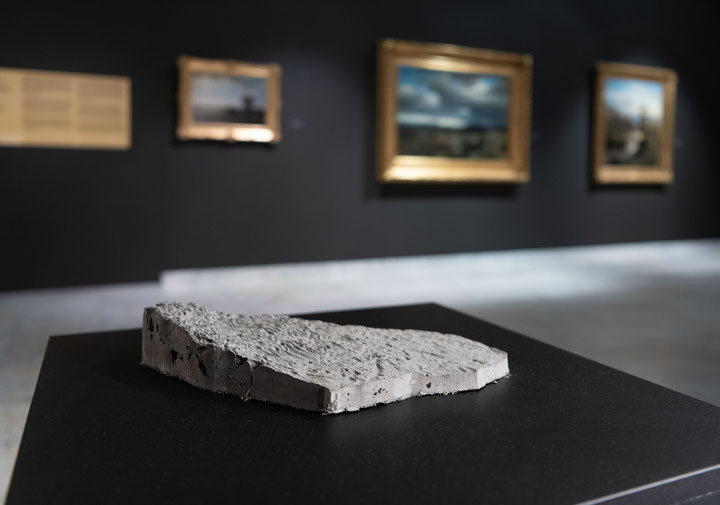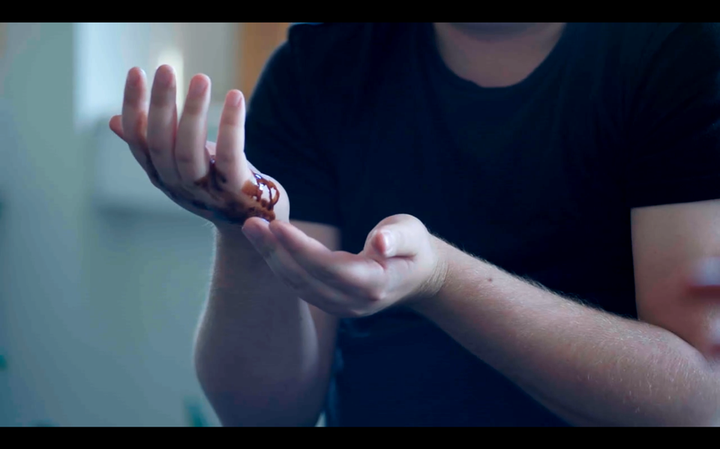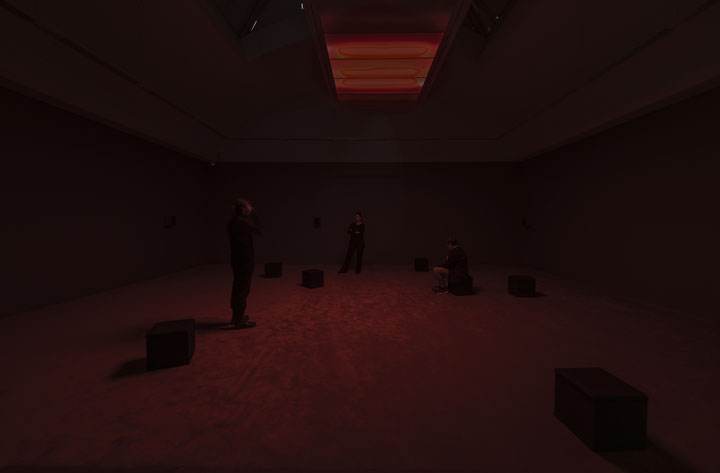Issue 2/2022 - Net section
Oily Matters
An Exhibition at Stavanger Art Museum Took on the Complexities around Oil
Norway, Stavanger Art Museum. I am looking at a coastal landscape by Lars Hertervig, one of the renowned painters of Norwegian National Romanticism. It depicts a small boat with people in the middle of craggy mountains, the strong effects of light and shadow in the gloomy sky create a dreamy and nostalgic atmosphere. Across the painting there is an edgy-shaped small black sculpture and a QR code somewhat “parasiting” this typical museal setting. Upon scanning the QR code I am taken to an App named Goliat, Draugen & Maria (2021), and I am further instructed to unlock a film by scanning the sculpture from above. Goliat, Draugen and Maria are the names of oil fields on the Norwegian continental shelf, for which there are publicly accessible geodata. These names also serve as the title of a multi-part project by Liv Bugge. The artist created three sculptures that are copies of the topography of the above-mentioned oil fields, an app and a film, in order to show how interwoven oil is with Norwegian identity. Although the downloading, opening and scanning takes time, it is worth the effort. The film which the sculpture unlocks is showing a group of people physically interacting with crude oil in a setting that somewhat reminds one of a somatic experiencing session. Their exercise with raw oil foregrounds sensing and feeling as a mode of discovery, and reveals the participant’s conflicting emotions towards oil as a substance on which the wealth of the country is based. Every now and then the film cuts to archival images from oil rigs, which are somehow attractive in their monstrosity, just as the rough and imposing Norwegian landscape is in front of me. I see the old and the new romanticism of Norway, the latter laying a little deeper beneath the surface of the sea.
Within the context of the exhibition Experiences of Oil (12 November to 18 April 2022), curated by Anne Szefer Karlsen and Helga Nyman at Stavanger Art Museum, which explored the social, cultural and emotional aspects connected to oil and affiliated extractive industries, and which explored the kinship between different “petro-states”, Bugge’s work points towards the public debate on oil as a resource that is both a gift and a curse, a substance so strongly embedded within the social tissue that it is barely possible to imagine a life without it. Thanks to the discovery of crude oil in Norway in the late 1960s, and the gradual growth of the industry through its expansion to other countries, Norway maintains one of the highest socio-economic standards of living in the world. The dissonance comes mainly from the darker side of oil extraction, the greenhouse gas emissions it produces, which significantly contribute to climate change. “If you think about it, isn’t it unsettling that we drill inside the earth to dig out the remains of our ancestors just to burn them for energy?”, notices Bugge. Two of their sculptures are located in public space, while the third sits in the part of the museum dedicated to historical paintings. Through this spatial positioning between inside and outside, public space as well as the digital realm, the work is playing on the threshold between the visible and the invisible, just like oil itself.
Being in the actual exhibition among artworks of artist from different oil-nations I have a feeling that we are all bodies of oil. There is a strong need to connect oil experiences with one another, as much as these do vary. Things that people think and feel in relation to oil and oil politics might be also different depending on where one is coming from. One of the strongest works in the show capturing the spectrum of human emotional states in relation to not only oil, but to the extraction of resources and the consequences thereof in general, is Otobong Nkanga’s immersive 6-channel sound installation Wetin You Go Do? Oya na (2020). Situated in a separate room with dimmed reddish-brown light, it speaks of a world that is broken and one’s relationship with powerlessness. The viewer is surrounded by a sea of voices: they are singing, humming, screaming. One of them quietly repeats the question “What are you going to do, what are you going to do?” in broken English, another one is ranting about being the problem, yet another one laments the freedom “to be what one wants to be”. The voices one can hear belong to the artist herself, the score is based on six different characters and states that she has been embodying in relation to different states of crises, not only recent ones. “We have a tendency to look at the world from a very short perspective”, says Nkanga in a conversation we had around the exhibition. We came to talk how oil is entangled with structures of power, and the feeling of guilt that comes from this position – something that I bring into the conversation sensing it in relation to Norwegian oil politics. For Nkanga guilt is a narcissistic emotion that centers everything back on oneself. “When we are talking about guilt, what is that guilt, is it the guilt of extraction, or the guilt of the system that has been put in place to allow for added value and growing wealth?”
Oil is a problem that calls for many solutions, but also a seductive substance, which permeates our modern existence. How could life be without it? As part of the Experiences of Oil opening conference, Kuwaiti artist Monira Al Qadiri speculated on post-oil futures in her brilliant lecture-performance The Petro-Historial Complex (2018). In it, Al Qadiri compares oil to a drug that one can never get enough of, linking it with the social and economic histories of the gulf region. In the exhibition space one can see her shiny levitating sculptures of oil drills, which, turned downside up, transfix the viewers. In the lecture these floating objects are utilized to depict a story from a certain future in which there is too much oxygen in the atmosphere because of the overuse of clean energy, and scientists are coming up with an idea to drill the sky to make holes in the ozone layer in order to provide the earth with more heat. Another story in the lecture brings back the forgotten pearl diving industry, on which the economy of the Gulf was once based on. Eventually, she mixes the past with the future, pre-empting the end of oil, pointing to a not-so distant future in which we might have to learn to live in a different, less oil-dependent and oil-driven world.
https://stavangerkunstmuseum.no/en/events/opplevelser-av-olje



